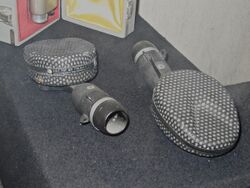Engineering:Coles 4038
The Coles 4038 is a ribbon microphone produced by Coles Electroacoustics. The microphone was designed and patented by the BBC in the 1950s[1] and was originally known as the STC 4038.[2] The sound of the microphone has been described as "British" with a "BBC politeness",[3] and its appearance has been likened to that of a waffle iron.[4] It is used in both sound recording and radio broadcasting.[5]
History
The microphone was designed by the BBC in 1953 and the prototype was assigned the model number BBC PGS/1.[6] It was designed as a result of the BBC's request for a strong and affordable microphone that was smaller than previous models[7] (such as the Type A). The 4038 was an improvement on the Type A's frequency response, and was described as "less obtrusive".[8]
The microphone was produced by Standard Telephones and Cables[9] before their manufacturing was transferred to Coles in the mid-1970s.[10] Since its design in the 1950s, the technical specifications of the 4038 have remained unchanged.[11]
Use
Recording
In recording environments, the 4038 is often used as drum overheads and on brass instruments.[3][12] The microphone became a favourite of British recording engineers in the 1950s and 60s, but did not receive widespread use in the United States.[12] The microphone was described as recording sounds "bigger than life" – such as drums or amplified guitars – some Beatles and Led Zeppelin recordings featured 4038s as overhead microphones on the drum kit.[13][14]
In a 1994 interview, Steve Albini said that "if [he] owned one mic, this would be it".[1] Albini has also commented that "really nothing beats them as an overhead on a drum kit".[14]
Broadcast
At one point, Bush House (home of the BBC World Service) used the 4038 almost exclusively.[15]
Technical
The 4038's frequency response is flat, with a range of approximately 30–15,000 Hz.[16] The attenuation of high frequencies reduces sibilance on vocals, but also reduces detail.[3]
The microphone uses a bi-directional polar pattern.[17]
The microphone is connected using a Western Electric jack connector designated 4069, which adapts the microphone's 3-pin output to a standard XLR connector.[18]
- Sensitivity (at 1,000 Hz Open Circuit Voltage)
- -65dB re: 1 Volt/Pa[19]
- Impedance
- 300 ohms
- Produced
- 1950s–present
Footnotes
- ↑ Jump up to: 1.0 1.1 (Schultz 2000)
- ↑ (White 2010)
- ↑ Jump up to: 3.0 3.1 3.2 (Cotton 2007)
- ↑ (Fuston 2008)
- ↑ (Leonard 2001)
- ↑ (Shaw 2008)
- ↑ (Streicher Dooley)
- ↑ (Institution of Electrical Engineers 1961)
- ↑ (Standard Telephones and Cables 1961)
- ↑ (Coutant 2009)
- ↑ (Electronic musician 2005)
- ↑ Jump up to: 12.0 12.1 (Owsinski 2004)
- ↑ (Streicher Dooley)
- ↑ Jump up to: 14.0 14.1 (Shechmeister 2011)
- ↑ (Hi-Fi News 1997)
- ↑ (Coles 2002a)
- ↑ (Coles 2002b)
- ↑ (Standard Telephones and Cables 1961)
- ↑ (Dooley 2006)
Sources
- Coles (2002a), 4038 Studio Ribbon Microphone, Hoddesdon, Hertfordshire: Coles Electroacoustics Ltd., http://www.coleselectroacoustics.com/micstudio.shtml, retrieved 5 May 2011
- Coles (2002b), 4038 Studio Ribbon Microphone Technical Specification, Hoddesdon, Hertfordshire: Coles Electroacoustics Ltd., http://www.coleselectroacoustics.com/micstudio_technical.shtml, retrieved 5 May 2011
- Coutant, Stan (2009), STC Brochures, Drums, PA: Coutant.org, http://www.coutant.org/stc/index.html, retrieved 5 May 2011
- Cotton, Jon (2007), Ribbon Mics On Test, Cambridge, Cambridgeshire: Sound on Sound, http://www.soundonsound.com/sos/dec07/articles/ribbonmicspt2.htm, retrieved 5 May 2011
- Dooley, Wes (2006), Coles 4038 Studio Ribbon Microphone, Pasadena, CA: Audio Engineering Associates, http://www.wesdooley.com/pdf/Coles_4038_Data_Sheet_web.pdf, retrieved 8 May 2011
- Electronic musician (2005), Electronic Musician, 21, New York, NY: Penton Media, https://books.google.com/books?id=LXYJAQAAMAAJ, retrieved 5 May 2011
- Fuston, Lynn (2008), "Coles Electroacoustics 4038", EQ Magazine (Recording Hacks), http://recordinghacks.com/microphones/Coles/4038, retrieved 25 September 2011
- Hi-Fi News (1997), Issues 1-6, 42, Poole, Dorset: Link House Publications, https://books.google.com/books?id=mjM9AQAAIAAJ, retrieved 8 May 2011
- Institution of Electrical Engineers (1961), The Proceedings of the Institution of Electrical Engineers Part 2, 108, London: The Institution, https://books.google.com/books?id=RStWAAAAMAAJ, retrieved 8 May 2011
- Leonard, John A (2001), Theatre Sound, Abingdon, Oxfordshire: Routledge, ISBN 0-87830-116-X
- Owsinski, Bobby (2004), The Recording Engineer's Handbook, Milwaukee, WI: Hal Leonard, ISBN 1-932929-00-2
- Schultz, Barbara (2000), Music Producers: Conversations with Today's Top Hit Makers, Milwaukee, WI: Hal Leonard, ISBN 0-87288-730-8
- Shaw, Alan A (2008), BBC Monitors 1922-1960, Haywards Heath, West Sussex: Harbeth Loudspeakers, http://www.harbeth.co.uk/uk/index.php?section=aboutus&page=harbethhistory&pageno=1, retrieved 5 May 2011
- Shechmeister, Matthew (11 January 2011), Relics Reborn: Ribbon Microphones Rally for Vintage-Audio Geeks, San Francisco, California: Wired Magazine, https://www.wired.com/rawfile/2011/01/gallery-ribbon-mics-part-1/?pid=568, retrieved 8 May 2011
- Standard Telephones and Cables (1961), 4038 Ribbon Microphone, London: STC, http://www.coutant.org/stc/4038/4038.pdf, retrieved 5 May 2011
- Streicher, Ron; Dooley, Wes (1997), Coles 4038 Studio Ribbon Microphone User's Guide, Pasadena, CA: Audio Engineering Associates, http://www.wesdooley.com/pdf/4038C.pdf, retrieved 5 May 2011
- White, Paul (2010), NI Abbey Road 60s Drums Sample Library, Cambridge, Cambridgeshire: Sound on Sound, http://www.soundonsound.com/sos/dec07/articles/ribbonmicspt2.htm, retrieved 8 May 2011
Further reading
- Shorter, D E L; Harwood, H D (1955), "The Design of a Ribbon Type Pressure Gradient Microphone", BBC Engineering Division's Monograph #4 (London: British Broadcasting Corporation), http://downloads.bbc.co.uk/rd/pubs/archive/pdffiles/monographs/bbc_monograph_04.pdf


